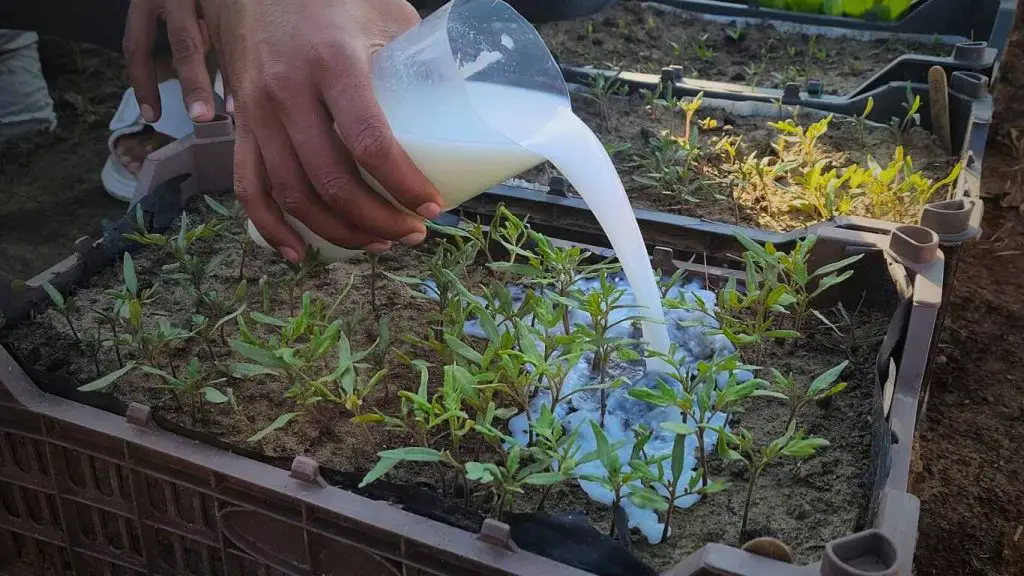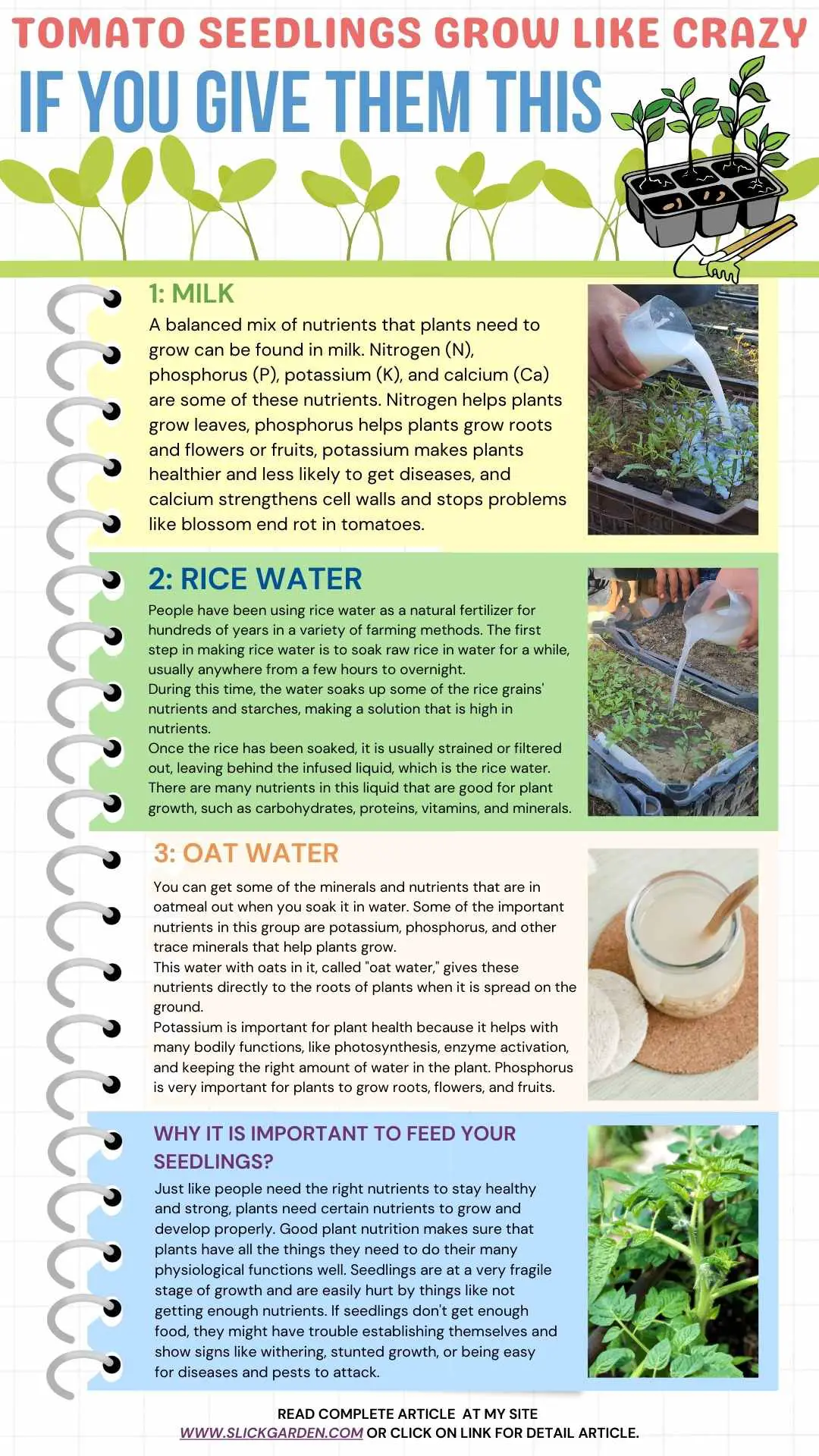To grow strong, high-quality seedlings, you need to feed your plants well. Young plants are especially vulnerable and often die from withering, but by adding certain things, you can greatly improve their growth.

Why It Is Important To Feed Your Seedlings?
- Importance of Good Plant Nutrition: Just like people need the right nutrients to stay healthy and strong, plants need certain nutrients to grow and develop properly. Good plant nutrition makes sure that plants have all the things they need to do their many physiological functions well.
- Enhancing Seedling Quality: Seedlings are at a very fragile stage of growth and are easily hurt by things like not getting enough nutrients. If seedlings don’t get enough food, they might have trouble establishing themselves and show signs like withering, stunted growth, or being easy for diseases and pests to attack.
- Incorporating Specific Ingredients: To help seedlings grow and get better, it’s important to add certain things to the area where they are growing. Essential nutrients like nitrogen, phosphorus, and potassium are often found in these ingredients, as well as micronutrients like calcium, magnesium, and iron. Furthermore, organic matter and helpful microorganisms can also help plants grow in a healthy way.
- Significantly Enhancing Growth: Seedlings can grow a lot faster if they get the right mix of nutrients and other things that help plants grow. This makes the plants stronger and healthier, so they can handle stresses from their environment better and produce better crops.
3 Ingredients That Will Make Your Seedlings Healthy

By knowing how important these things are, you can make sure that your seedlings grow into healthy, strong plants that will help your garden or crop harvest. These tips will help your seedlings get off to the best start possible.
1: Milk
- Nutrient Composition: A balanced mix of nutrients that plants need to grow can be found in milk. Nitrogen (N), phosphorus (P), potassium (K), and calcium (Ca) are some of these nutrients. Nitrogen helps plants grow leaves, phosphorus helps plants grow roots and flowers or fruits, potassium makes plants healthier and less likely to get diseases, and calcium strengthens cell walls and stops problems like blossom end rot in tomatoes.
- Lactic Acid Bacteria: Lactic acid bacteria, which are good for you, are found in milk. These bacteria can live on plants and soil surfaces and protect them from pathogens that are harmful. In this way, they help the plant’s natural defenses work better, which makes it less likely to get sick or be stressed.
- Application Methods: There are different ways to use milk on plants. It can be mixed with water and then put on the soil around the roots of a plant. This lets the roots take in the nutrients. It can also be watered down and sprayed on the leaves, where the plant’s stomata (tiny pores on the leaf surface) can take in the nutrients.
- Benefits: People think that using milk to feed and protect plants is a natural and long-lasting way to garden. It gives plants the nutrients they need in a form that they can easily take in and use. The presence of lactic acid bacteria can also improve the health of the soil by encouraging good microbes to work.
2: Rice Water
People have been using rice water as a natural fertilizer for hundreds of years in a variety of farming methods. The first step in making rice water is to soak raw rice in water for a while, usually anywhere from a few hours to overnight.
During this time, the water soaks up some of the rice grains’ nutrients and starches, making a solution that is high in nutrients.
Once the rice has been soaked, it is usually strained or filtered out, leaving behind the infused liquid, which is the rice water.
There are many nutrients in this liquid that are good for plant growth, such as carbohydrates, proteins, vitamins, and minerals.
When applied to plants, rice water provides several benefits:
- Providing nutrients: The nutrients in rice water are a natural way for plants to get food, which helps them grow and develop in a healthy way.
- Soil conditioning: Adding organic matter and essential nutrients to the soil with rice water makes it more fertile. It also improves the structure of the soil and supports a healthy community of microbes.
- Better plant health: Plants that are treated with rice water often have better overall health, more vigor, and are less likely to die from stress. This means that they produce more and better-quality food.
- Cost-effectiveness: Rice water is a cheap and environmentally friendly way to fertilize plants because it uses ingredients that are easy to find and reduces the need for synthetic fertilizers.
- Environmentally friendly: Growers can use less chemical fertilizers when they use rice water as a natural fertilizer. This reduces pollution and encourages long-term farming practices.
Related Articles About Homemade Fertilizers:
- 15 Simple And Inexpensive Homemade Fertilizers
- How To Make Liquid Fertilizer At Home For Your Plants?
- How To Make Liquid Fertilizer From Kitchen Waste
3: Oat Water
You can get some of the minerals and nutrients that are in oatmeal out when you soak it in water. Some of the important nutrients in this group are potassium, phosphorus, and other trace minerals that help plants grow.
This water with oats in it, called “oat water,” gives these nutrients directly to the roots of plants when it is spread on the ground.
Potassium is important for plant health because it helps with many bodily functions, like photosynthesis, enzyme activation, and keeping the right amount of water in the plant. Phosphorus is very important for plants to grow roots, flowers, and fruits.
Oat water can also help make the structure of the soil better. The oats’ organic matter can improve the texture of the soil, making it easier for roots to grow by making it more friable. It can also encourage the activity of microbes in the soil, which is good for the health and fertility of the soil.
If seedlings in a vegetable garden can get these nutrients and the soil is in better shape, the plants will grow stronger and healthier with better root systems. In turn, this leads to better establishment and growth, which means higher yields when it’s time to harvest.
Overall, oat water is a safe and eco-friendly way to feed plants and make the soil better, which makes it an important tool for gardeners who want to grow healthy, productive plants.
